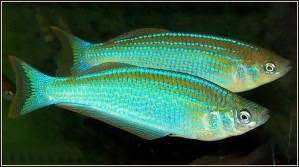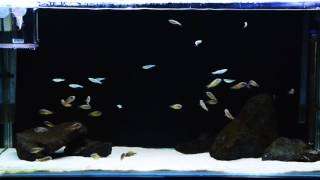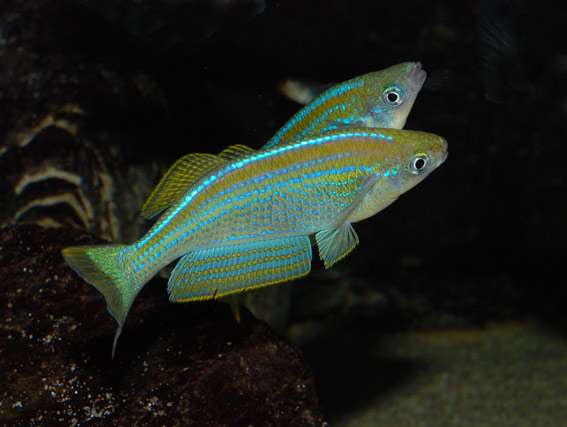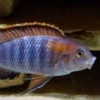As the Fish of the Month for March, there will a bag of 5 x Lamprichthys tanganicanus "Tanganyika Killifish" around 5-cm available at the PCS Meeting for auction. These are special lots to raise money for Stuart Grant Fund for Cichlid Preservation and have kindly been donated by one of our PCS Members - TheChief (Dave).

Lamprichthys tanganicanus "Tanganyika Killifish"
This species can be found in Congo, Burundi, Tanzania and Zambia.
Endemic to the shore regions of Lake Tanganyika. Introduced in Lake Kivu.
The Lamprichthys tanganicanus (Tanganyika killifish) is a species of poeciliid endemic to Lake Tanganyika, where it forms large schools, mainly close to rocky shores but also pelagically off shore. It is an egglayer with external fertilization, and deposits its eggs in narrow crevices. It is fished commercially for food, and also for the aquarium trade.
This species is generally available in specialized trade or at aquarium clubs. Fish from long-term breeding are a little easier to breed, but special water parameters must be respected.
Common names: Tanganyika Killifish,

Size
Males up to 15cm/6” in length. Females smaller.
Classification
Cichlidae - Actinopterygii (ray-finned fishes) > Cyprinodontiformes (Rivulines, killifishes and live bearers) > Poeciliidae(Poeciliids) > Procatopodinae
Distribution
Lake Tanganyika endemic. Inhabits rocky shores, but also found offshore. Not a seasonal killifish.
Diet
The Lamprichthys tanganicanus is an insectivore, planctophage and vermivore.
Feed a mix of mainly live and frozen foods, including Mysis, Artemia and mosquito larvae. Some dry foods, like flake, will also be taken. This species can be fed dry foods (flakes, pellets), fresh food and frozen food. To avoid deficiencies, it is recommended to vary the types of food.
Feeding Frequency: As with all fish, do not over feed them to avoid polluting the water. For an adult fish, you can feed it once a day.
Maintenance
Minimum 90cm/36” aquarium, though larger tanks are better and can house a group.
Although the lake is full of cichlids this species is actually best housed away from cichlids in all but the largest aquaria, as it is much more delicate and cannot tolerate continued cichlid aggression.
These fish have a reputation for being sensitive to poor water quality and susceptible to disease. Treat them very carefully for the first few days or weeks to avoid accidents.If you do want to mix cichlids with it in a biotope. Cyprichromis and Paracyprichromis are best, or have shell dwellers in a deep tank where the killies can occupy the open water above.
The Lamprichthys tanganicanus naturally lies in a basic water. The soil is usually made up of pebbles and rocks.
Being fearful in nature, it is advisable not to coexist the Lamprichthys tanganicanus with larger territorial species or with too aggressive fish. It can easily evolve with neighboring territorial temperament peaceful or non-territorial species little aggressive.
Be careful to provide an adequate development for each territorial species: each species must have a surface and a scenery allowing it to juxtapose its territory to that of its neighbors.
This fish being polygamous, the male must always be maintained with several females. A ratio of three females to one male appears to be a good compromise for group formation.
Males have the distinction of being particularly oppressive with females. This behavior can tire the females to a point that sometimes leads to their death. It is important to set up a planted aquarium with numerous shelters.
The Lamprichthys tanganicanus living naturally in alkaline water, the presence of limestone grit type or travertine improve its environment. It is also advisable to add sand with a specific salt intake to stabilize the pH, to gauge according to the hardness of the water used. To stick better with its biotope, you can cover the bottom of the sandbox and deposit a pile of stones to form caves.
Water Changes: To prevent the water from becoming too polluted, it is recommended to carry out a monthly renewal of 20% to 30% of the volume of water. Be careful, the added water must be at a temperature close to that of the aquarium.
Temperature: 73-77°F (23-25°C) pH: 8.0-9.0 dH range: 12 - 16

Character
The Lamprichthys tanganicanus is a fish living in small groups that naturally resides at mid-depth. The members of each group are organized around a well-established hierarchy. It is a species with a rather lively temperament. Although slightly territorial, Lamprichthys tanganicanus remains a rather peaceful fish that generally behaves peacefully with other species.
It should be noted that it is less tolerant with its congeners. The Lamprichthys tanganicanus is a polygamous fish that lives naturally in the harem.
Males can be over-attentive towards females, so outnumber them by at least two to one. Two males showing off to each other is a wonderful sight.

Spawning
Males perform a courtship dance before enticing females to spawn and leave the fertilised eggs in crevices in rocks. They can be bred in captivity, though the eggs are normally removed straight after spawning and reared away from the main tank.
It is an egg layer with external fertilization, and deposits its eggs in narrow crevices.
Its reproduction in aquarium is considered rather easy. It ideally takes place at a temperature of around 26 ° C for a pH of 7.5.
Notes
This beautiful killifish is very rare in aquatic shops. It’s large and a non-annual, and differs from the tiny killies we normally associate with as it doesn’t inhabit diminutive ponds, ditches and streams. Instead it inhabits Lake Tanganyika, one of the world’s largest bodies of fresh water.
Males can be over-attentive towards females, so outnumber them by at least two to one. Two males showing off to each other is a wonderful sight.










